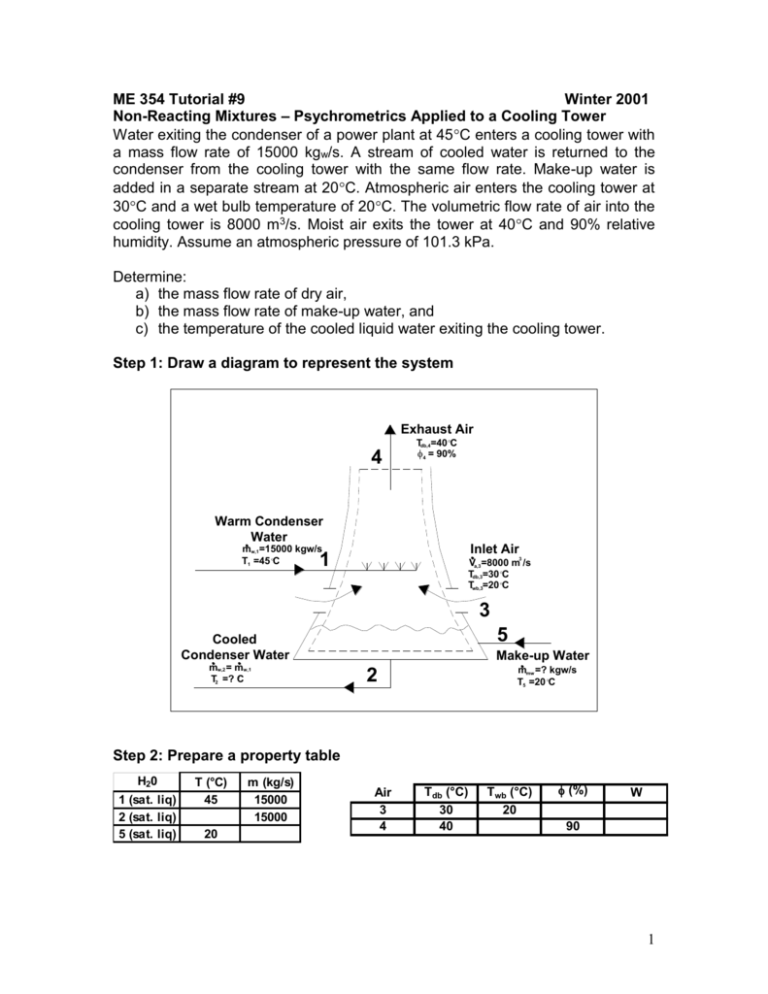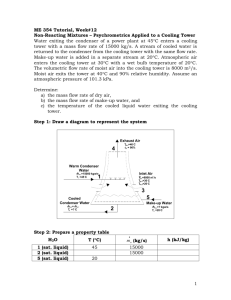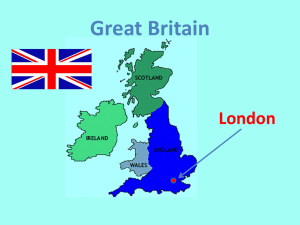Non-Reacting Mixtures – Psychrometrics Applied to a Cooling Tower
advertisement

ME 354 Tutorial #9 Winter 2001 Non-Reacting Mixtures – Psychrometrics Applied to a Cooling Tower Water exiting the condenser of a power plant at 45C enters a cooling tower with a mass flow rate of 15000 kgw/s. A stream of cooled water is returned to the condenser from the cooling tower with the same flow rate. Make-up water is added in a separate stream at 20C. Atmospheric air enters the cooling tower at 30C and a wet bulb temperature of 20C. The volumetric flow rate of air into the cooling tower is 8000 m3/s. Moist air exits the tower at 40C and 90% relative humidity. Assume an atmospheric pressure of 101.3 kPa. Determine: a) the mass flow rate of dry air, b) the mass flow rate of make-up water, and c) the temperature of the cooled liquid water exiting the cooling tower. Step 1: Draw a diagram to represent the system Exhaust Air 4 Tdb,4=40 C f4 = 90% Warm Condenser Water Inlet Air mw,1=15000 kgw/s T1 =45 C 1 3 Va,3=8000 m /s Tdb,3=30 C Twb,3=20 C 3 5 Cooled Condenser Water mw,2 = mw,1 T2 =? C Make-up Water mmw =? kgw/s T5 =20 C 2 Step 2: Prepare a property table H20 1 (sat. liq) 2 (sat. liq) 5 (sat. liq) T (°C) 45 20 m (kg/s) 15000 15000 Air 3 4 Tdb (°C) 30 40 Twb (°C) 20 f (%) W 90 1 Step 3: State your assumptions Assumptions: 1) The cooling tower operates under steady conditions 2) KE, PE 0 3) Cooling tower is rigid W cv = 0. 4) Heat transfer with the surroundings is neglected 5) Assume all liquid is saturated 6) The pressure is constant throughout the cooling tower at 101.3 kPa. Step 4: Calculations Part a) The mass flow rate of dry air can be determined using the volumetric flow rate of air into the cooling tower (given in the problem as 8000 m 3/s) and the specific volume of this air as shown in Eq1. ma ,3 V a ,3 v a ,3 (Eq1) We can determine the specific volume of the air entering the cooling tower by determining the state point of location 3 on the psychrometric chart using T db,3 = 30C and Twb,3 = 20C. From the psychrometric chart, va,3 = 0.873 m3/kga Substituting this value and the given volumetric flow rate into Eq1 we can determine the mass flow rate of dry air. ma , 3 V a ,3 v a ,3 m3 8000 s = 9163.8 kg /s a m3 0.873 kga Answer a) Part b) To determine the mass flow rate of the make-up water, denoted as m mw , we can perform a mass balance on the water entering/exiting our cooling tower control volume. At location 1 we have the stream of water entering the cooling tower from the condenser, which we will denote as m w,1 . At location 2 we have the stream of water exiting the cooling tower to be returned to the condenser, which we will denote as m w, 2 . We are told in the problem statement that m w,1 = m w, 2 = 2 m w . At location 3, we have the moisture entering the cooling tower control volume carried in by the incoming air. We will denote this as m w,3 . At location 4, we have the moisture leaving the cooling tower control volume carried out by the exiting air. We will denote this as m w, 4 . The mass balance on the water is performed in Eq2. m w m w m w,3 m w, 4 m mw 0 m mw m w, 4 m w,3 (Eq2) We can express m w,3 & m w, 4 in terms of the corresponding mass flow rates of dry air at location 3 & 4 and their respective humidity ratios W 3 & W4 as shown in Eq3 and Eq4. m w,3 W3 m a ,3 (Eq3) m w, 4 W4 m a , 4 (Eq4) Substituting Eq3 and Eq4 into Eq2 we obtain Eq5. m mw m w, 4 m w,3 W4 m a , 4 W3 m a ,3 (Eq5) From our assumption that the cooling tower operates in a steady manner, the mass flow rate of air will be constant i.e. m a ,3 = m a , 4 = m a . Eq5 can be rewritten as Eq6. m mw m a (W4 W3 ) (Eq6) Recall that we determined the mass flow rate of dry air in part a). We can determine the humidity ratio of the air entering the cooling tower by using state point 3 on the psychrometric chart. From the psychrometric chart, W 3 = 10.5 gw/kga = 0.0105 kgw/kga Unfortunately, state point 4 (Tdb,4 = 40C & f=90%) is off the psychrometric chart so we will have to calculate the value of W 4 using equation 13-11b from Cengel and Boles as shown below. 3 From Table A-4 @ T= 40C, Psat = 7.384 kPa. W4 kg 0.622f 4 Psat 0.622(0.9)(7.384) 0.0437 w P f 4 Psat 101.3 0.9(7.384) kga Substituting these values into Eq6, we can determine the mass flow rate of the make-up water. kg kg m mw m a (W4 W3 ) 9163.8 a 0.0437 0.0105 w s kga = 304 kgw/s Answer b) Part c) We can determine the temperature of the cooled liquid water exiting the cooling tower by first determining its enthalpy. Since we are assuming it is a saturated liquid we can use the enthalpy to interpolate in Table A-4 to determine its temperature. To find the enthalpy of the water exiting the cooling tower we must perform an energy balance on the cooling tower control volume. At location 1, the rate of energy entering the control volume carried in by the stream of water coming from the condenser is m w hw,1 , where h is used to denote enthalpy. At location 2 we have the stream of water leaving the cooling tower carrying away energy at a rate of m w hw, 2 . At location 3, the moist air carries energy at a rate of m a h3 into the control volume. At location 4, we have moist air leaving the cooling tower control volume carrying energy out at a rate of m a h4 . The make-up water carries energy into the control volume at a rate of m mw hmw . Combining all of these statements into one expression we obtain Eq7. Note: We have made use of our list of assumptions in developing Eq7. m w hw,1 m w hw, 2 m a h3 m a h4 m mw hmw 0 (Eq7) We can isolate the enthalpy of the water at location 2 by rearranging Eq7 as shown in Eq8. hw, 2 hw,1 m a (h3 h4 ) m mw hmw (Eq8) mw 4 We have previously determined m a and m mw , and we are given m w in the problem statement. hw,1 Since we have assumed saturated liquid water at location 1 we can determine hw,1 from Table A-4 using T1=45C. kJ hw,1 188.45 kgw h3 Using state point 3 on the psychrometric chart we can determine h 3. kJ h3 57.5 kga h4 As stated previously, state point 4 is off the psychrometric chart so we must calculate h4. Using equation 13-1a from Cengel and Boles, we can calculate the enthalpy of DRY AIR alone. kJ kJ hdryair, 4 1.005 (40 C ) 40.2 kga kga C We can calculate the enthalpy of the MOISTURE in the air using equation 13-4 from Cengel and Boles (or we can look it up in Table A-4 for hg @ T = 40C). kJ kJ hg , 4 (2501.3 1.82(40)) 2574.1 kgw kgw To combine the dry air and moisture enthalpies at location 4 into one term, h 4, we need to convert the enthalpy of the moisture to be on a “per kg of dry air” basis by multiplying it by the humidity ratio, W 4. kJ kg w kJ kJ h4 hdryair, 4 W4 hg , 4 40.2 0.0437 2574.1 152.7 kga kga kg w kga 5 hmw Since we have assumed saturated liquid water at location 5 we can determine hmw from Table A-4 using T5=20C. kJ hmw 83.96 kgw Substituting these values into Eq8, we can determine the enthalpy of the water at location 2. hw, 2 kJ kJ kg kgw 9163.8 a (57.5 152.7) (83.96) (304) kJ s s kga kgw 188.45 kg kgw 15000 w s kJ kJ kJ hw, 2 188.45 56.46 131.99 kgw kgw kgw As stated previously, since we have assumed saturated liquid water at location 2 we can use hw,2 to find the corresponding temperature in Table A-4. From Table A-4 we find that hw,2 lies in between the enthalpies corresponding to temperatures of 30C and 35C. We can interpolate in between them to find the temperature of the water exiting the cooling tower. T 30 C 131.99 125.79 2 146.68 125.79 35 C 30 C T2 = 31.5C Answer c) Step 5: Summary a) the mass flow rate of dry air is 9163.8 kga/s b) the mass flow rate of make-up water is 304 kgw/s, and c) the temperature of the cooled liquid water exiting the cooling tower is 31.5C. 6







